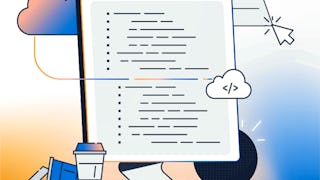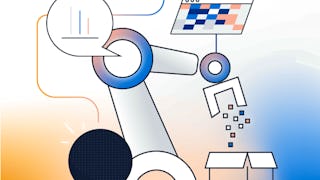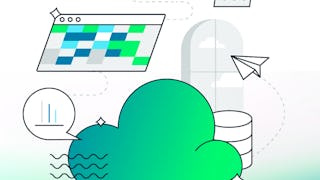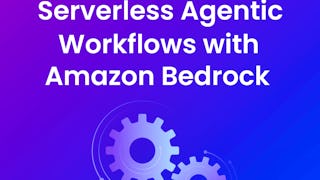This course gives you a thorough introduction to the python programming language. You'll start by learning the definition of python, its history, semantics, and how it works. The first week concludes by writing a python script to solve a problem. In Week 2, you'll learn about Serverless Architectures and understand the differences between microservices, service-oriented and monolith architectures. You'll build a microservices architecture by learning how to use the following tools: AWS Lambda, Amazon API Gateway, and Cloud9. It's then time to go deep with AWS Databases. You'll see Amazon RDS and Amazon DynamoDB in action, visualizing the important role they play in developing applications in python. The course's final week will cover application integration services. Amazon's Simple Notification Service (SQS), Simple Queue Service (SQS), and EventBridge take center stage as important “glue” components for scalable, cloud-based applications. You'll close the course with a hands-on project, writing some code to use some hardcoded data to write to dynamodb and then convert that into a lambda function.


Python for Serverless Applications and Automation on AWS
本课程是 AWS Cloud Support Associate 专业证书 的一部分


位教师:Morgan Willis
2,915 人已注册
包含在  中
中
您将学到什么
Introductory level Python programming and Python packages
Explain the different roles in an organization building software
您将获得的技能
要了解的详细信息

添加到您的领英档案
7 项作业
了解顶级公司的员工如何掌握热门技能

积累 Cloud Computing 领域的专业知识
- 向行业专家学习新概念
- 获得对主题或工具的基础理解
- 通过实践项目培养工作相关技能
- 通过 Amazon Web Services 获得可共享的职业证书

该课程共有4个模块
This module starts with how to develop applications in a team. An application engineer doesn’t work alone, and you learn how an engineer interacts with roles such as architects, product managers, quality assurance (QA), support, and DevOps teams. Next, you learn the basics of Python programming. The goal is to get you to the level where you can read and understand some basic Python code. If you already know a programming language, many of the features of Python will look similar to the programming languages you already know.
涵盖的内容
12个视频10篇阅读材料2个作业2个插件
This module focuses on software architecture. You learn about AWS Lambda as a home for your application code. You also investigate three different types of application architecture: microservices architecture, monolithic architecture, and service-oriented architecture. You walk through a conceptual ecommerce application, and compare how to build an application based on each architecture type. Next, you learn how to expose your application logic as an application programming interface (API). In a lab environment, you deploy a Lambda function and an Amazon API Gateway API by using the AWS Serverless Application Model (AWS SAM).
涵盖的内容
7个视频2篇阅读材料1个作业1个应用程序项目
In this module, you learn about using a database for your application data. You explore both relational databases with Amazon Relational Database service (Amazon RDS), and NoSQL databases with Amazon DynamoDB. You learn about the differences between relational databases and NoSQL databases, and when you would choose one type of database instead of the other. You also explore different examples of how to access relational databases and DynamoDB from a Python application.
涵盖的内容
6个视频1篇阅读材料1个作业1个应用程序项目
This module introduces you to the idea of using python for automating tasks related to IT support and operations. It’s common to automate repeatable tasks with python scripts, and you’ll explore specific scenarios for automation with python as well as hosting automation scripts using AWS services like AWS Systems Manager. You will see an example of creating an AWS Lambda function hosting a python script that will be used in an AWS Systems Manager Automation runbook. This module will give you a better idea of how to use python to automate tasks and processes.
涵盖的内容
7个视频3篇阅读材料3个作业2个应用程序项目1个插件
获得职业证书
将此证书添加到您的 LinkedIn 个人资料、简历或履历中。在社交媒体和绩效考核中分享。
从 Cloud Computing 浏览更多内容

Amazon Web Services

Amazon Web Services

Amazon Web Services
 状态:免费
状态:免费DeepLearning.AI
人们为什么选择 Coursera 来帮助自己实现职业发展




常见问题
To access the course materials, assignments and to earn a Certificate, you will need to purchase the Certificate experience when you enroll in a course. You can try a Free Trial instead, or apply for Financial Aid. The course may offer 'Full Course, No Certificate' instead. This option lets you see all course materials, submit required assessments, and get a final grade. This also means that you will not be able to purchase a Certificate experience.
When you enroll in the course, you get access to all of the courses in the Certificate, and you earn a certificate when you complete the work. Your electronic Certificate will be added to your Accomplishments page - from there, you can print your Certificate or add it to your LinkedIn profile.
更多问题
提供助学金,
